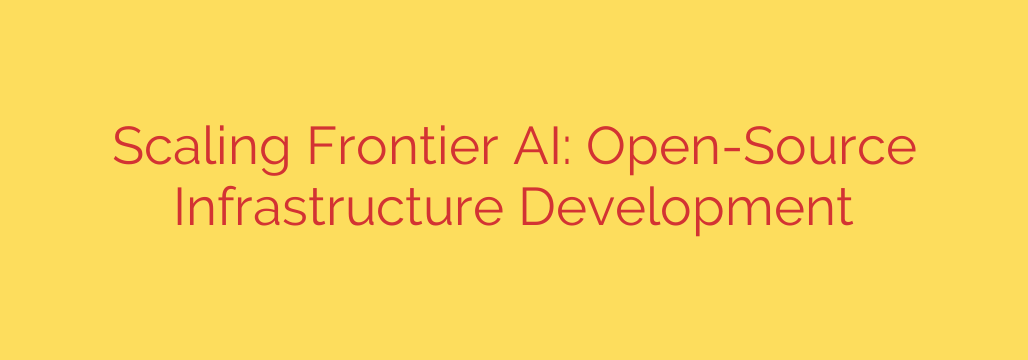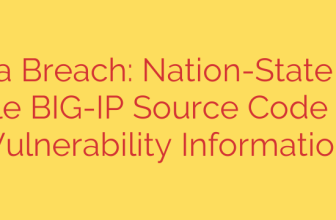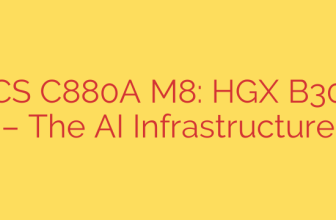
Powering the Future: Why Open-Source Infrastructure is Crucial for Scaling Frontier AI
The AI revolution is here, transforming everything from scientific research to daily business operations. At the heart of this transformation are “frontier” AI models—massive, complex systems like the large language models (LLMs) that power today’s most advanced chatbots and creative tools. However, building and training these digital minds presents an unprecedented engineering challenge.
As these models grow, so do their demands for data, processing power, and sophisticated management. Meeting this challenge requires more than just faster chips; it requires a new approach to the very foundation of AI development. This is where open-source infrastructure becomes not just a helpful option, but an absolute necessity.
The Immense Challenge of AI at Scale
To understand the problem, it’s important to grasp the scale we’re talking about. Early AI models were like small workshops, but today’s frontier models are like sprawling, continent-spanning factories. They involve:
- Trillions of Parameters: Models are increasingly complex, requiring vast computational power to train and operate.
- Exabytes of Data: Training data is measured in quantities that are difficult to comprehend, demanding highly efficient data processing and storage solutions.
- Massive Compute Clusters: Training a single frontier model can require thousands of specialized processors (GPUs) running in concert for weeks or even months.
The computational demands of these models are growing at an exponential rate, far outpacing the progress of individual hardware components. Simply put, building the next generation of AI is a systems-level problem that cannot be solved by any single company working in isolation.
The Open-Source Advantage in AI Infrastructure
An open-source approach provides a powerful framework for tackling these monumental challenges. By fostering a collaborative ecosystem, it accelerates innovation, enhances security, and ensures that the power of frontier AI doesn’t become concentrated in the hands of a few.
Here are the core benefits:
Accelerated Innovation and Collaboration: Open-source projects bring together the brightest minds from academia, startups, and major tech companies. This collective brainpower solves complex problems faster than any single organization could, leading to more robust and efficient tools for everyone. When a bug is found or an improvement is designed, the entire community benefits.
Democratizing Access to Powerful Tools: Proprietary, closed-off systems create high barriers to entry, stifling competition and innovation. Open-source infrastructure levels the playing field, allowing researchers and developers worldwide to build upon the latest advancements without being locked into a specific vendor’s expensive and rigid ecosystem.
Enhanced Transparency and Security: When source code is open, it can be scrutinized by security experts globally. This “many eyes” approach makes it easier to find and fix vulnerabilities before they can be exploited. Transparency builds trust and leads to more secure, reliable systems—a critical factor when dealing with infrastructure that powers world-changing technology.
Flexibility and Prevention of Vendor Lock-In: Relying on a single provider for critical infrastructure is risky. If that provider changes its prices, services, or business strategy, your operations can be severely impacted. Open-source standards give organizations the freedom to choose and combine the best tools for the job, ensuring they remain agile and in control of their technology stack.
Core Components of a Modern AI Stack
Building a scalable AI platform involves several key layers, many of which are dominated by successful open-source projects.
Compute Orchestration and Management: At the lowest level, you need to manage the thousands of processors working together. Tools like Kubernetes have become the de facto standard for orchestrating these complex workloads, ensuring that computational resources are used efficiently and reliably.
Data Processing and Pipelines: Before a model can be trained, vast amounts of data must be collected, cleaned, and processed. Open-source frameworks like Apache Spark and Ray are essential for building scalable data pipelines that can feed the voracious appetite of frontier models.
Model Training Frameworks: The software that actually defines and trains the AI models is almost entirely open-source. Frameworks like PyTorch and TensorFlow are the bedrock of modern AI research and development, providing the fundamental building blocks for creating new models.
Actionable Security Tips for Your AI Infrastructure
While open-source offers incredible benefits, it also requires a proactive approach to security. Managing a complex AI stack means you are responsible for its integrity.
Thoroughly Vet All Dependencies: Your platform is only as secure as its weakest link. Use automated tools to scan open-source libraries for known vulnerabilities and maintain a strict policy for vetting any new software before it’s integrated.
Implement a Zero-Trust Architecture: Assume no user or component is inherently trustworthy. Enforce strict access controls and authentication for every part of your infrastructure, from data storage to model training clusters. This minimizes the potential damage from a security breach.
Prioritize Continuous Monitoring and Auditing: The complexity of AI systems can hide security risks. Deploy robust monitoring solutions to track system behavior, log all access, and alert on any anomalous activity. Regular security audits are crucial for identifying and mitigating emerging threats.
Building the Future, Together
The journey toward more powerful and beneficial artificial intelligence is a marathon, not a sprint. The immense technical hurdles of scaling frontier AI cannot be overcome in silos. By embracing an open, collaborative, and security-conscious approach to infrastructure development, we can build a more innovative, accessible, and trustworthy AI ecosystem for everyone. The future of AI will not be built by one company; it will be built by a global community.
Source: https://azure.microsoft.com/en-us/blog/accelerating-open-source-infrastructure-development-for-frontier-ai-at-scale/








